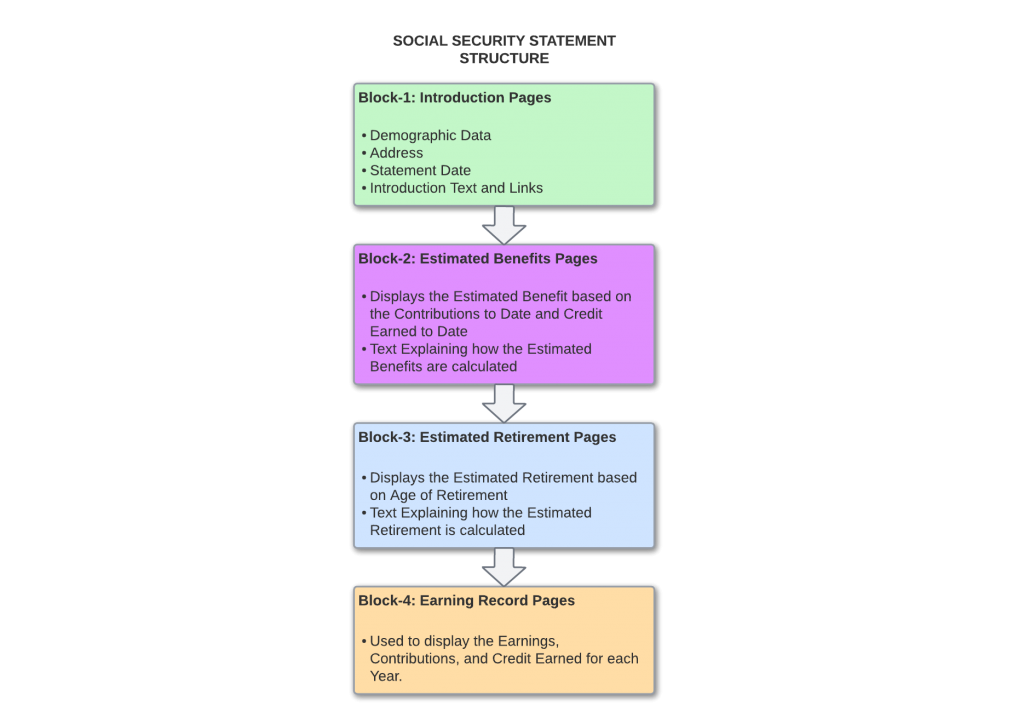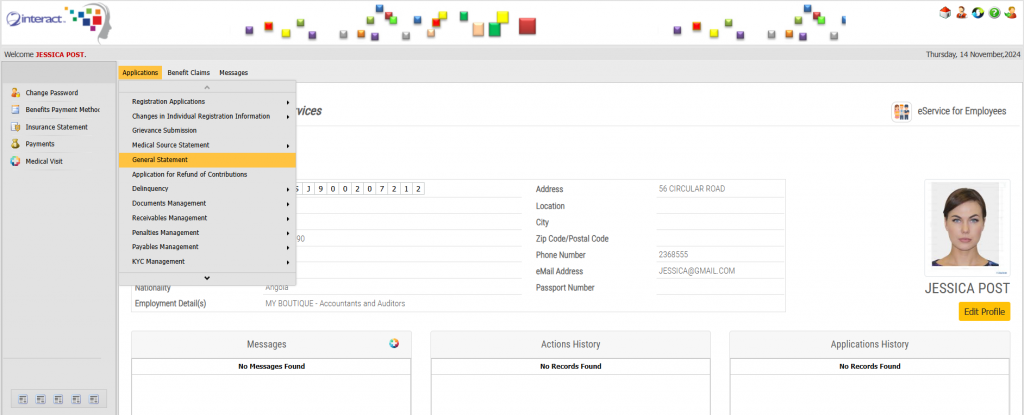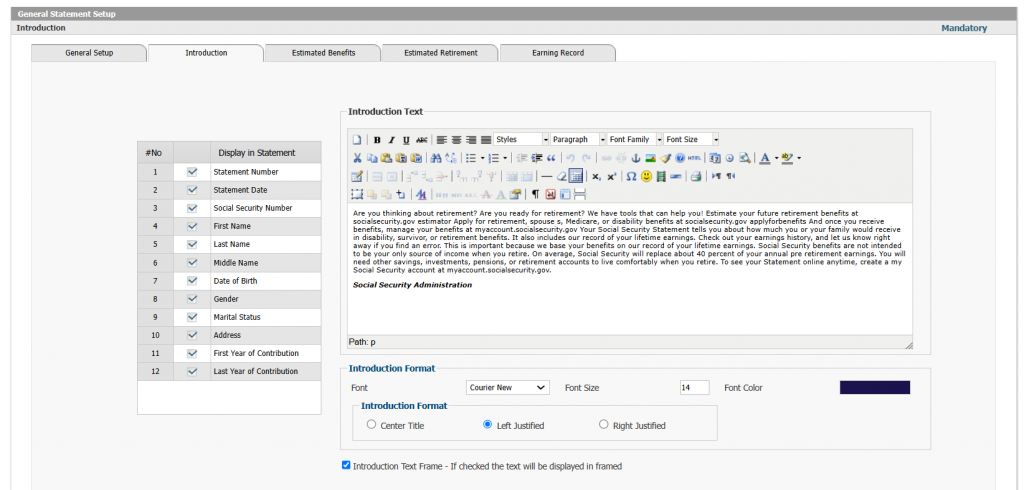Social security statements are critical documents that provide individuals with a snapshot of their earnings, contributions, and expected benefits. They serve as essential tools for both social security administrators and beneficiaries, enhancing transparency and empowering individuals to plan for their financial future. In this blog, we’ll discuss the purpose of social security statements, how they are used in the United States, the variations in statements across different countries, and the advanced features of social security statement management in Interact SSAS.
The Purpose of Social Security Statements
Social security statements are primarily designed to inform individuals about their contributions to the social security system and the benefits they are likely to receive. These statements typically include information such as annual earnings, total contributions, accrued credits, and estimated benefits. By providing a clear record of contributions and benefits, social security statements help individuals:
- Track Contributions and Earnings: Individuals can monitor their contributions to ensure accuracy and keep a historical record of their earnings.
- Estimate Future Benefits: Social security statements provide estimated benefits based on current contributions, helping individuals plan for retirement or other life events.
- Ensure Data Accuracy: Statements allow individuals to verify that their contributions are recorded correctly, helping prevent errors that could impact their future benefits.
- Gain Awareness of Entitlements: Statements educate individuals about the types of benefits they are entitled to, such as retirement, disability, or survivors’ benefits.
By fulfilling these functions, social security statements promote transparency, build trust, and empower individuals to make informed financial decisions.
Social Security Statements in the United States
In the United States, the Social Security Administration (SSA) issues annual social security statements to workers, detailing their earnings, contributions, and estimated benefits. These statements serve several important purposes:
- Estimated Retirement Benefits: U.S. social security statements provide an estimate of retirement benefits based on the individual’s current earnings record. The SSA calculates these estimates under different scenarios, such as early retirement at age 62, full retirement age, and delayed retirement.
- Disability and Survivors Benefits: Statements also inform individuals about their potential disability and survivors’ benefits. This feature helps individuals understand the protection social security provides in case of disability or death, supporting financial planning for unforeseen events.
- Verification of Earnings Record: The SSA encourages recipients to review their statements to ensure that their earnings are accurately recorded. Since benefits are based on lifetime earnings, any errors in the record could result in reduced benefits. The statement thus serves as a tool for individuals to verify and report discrepancies.
- Educational Information: U.S. social security statements provide general information about the social security program, eligibility requirements, and retirement planning tips, helping individuals make well-informed decisions regarding their benefits.
Overall, the U.S. social security statement is a comprehensive document that not only provides a financial summary but also offers educational resources to support individuals in planning for the future.
Social Security Statements in Other Countries
The content and format of social security statements vary from country to country, reflecting differences in social security systems, benefit structures, and regulatory frameworks. Here are some examples of how social security statements may differ:
- United Kingdom: In the UK, social security statements, also known as “State Pension Forecasts,” are issued by the Department for Work and Pensions (DWP). These statements focus primarily on retirement benefits, providing individuals with an estimate of their state pension based on National Insurance contributions. Unlike the U.S. system, which includes disability and survivors’ benefits, UK statements are often more retirement-focused.
- Canada: Canada Pension Plan (CPP) statements provide information on contributions and estimated retirement, disability, and survivors’ benefits. Similar to the U.S., Canadian statements include a record of contributions and credits, helping individuals verify their contributions and understand their potential benefits.
- Australia: In Australia, social security statements are integrated with the superannuation system, which is a mandatory retirement savings scheme. The Australian Tax Office (ATO) issues statements that provide individuals with information about their superannuation contributions and the estimated balance at retirement. Unlike the SSA in the U.S., which directly manages benefits, Australia’s system involves a mix of government and private sector management of retirement funds.
- European Union Countries: Many EU countries, such as Germany and France, issue social security statements that detail not only retirement benefits but also health and unemployment insurance contributions. These statements often reflect a more comprehensive social safety net compared to the U.S., covering a broader range of social benefits.
These examples illustrate how social security statements are tailored to the specific needs, policies, and regulatory frameworks of each country. While the core purpose remains the same—providing transparency and supporting financial planning—the content and structure of the statements vary significantly.
Social Security Statements in Interact SSAS
Interact SSAS (Social Security Administration Software) offers a highly configurable Social Security Statement Management module designed to meet the needs of diverse social security systems. This module allows social security agencies to generate detailed, customized statements for individuals, providing a clear picture of their contributions and benefits. Here’s an overview of how social security statements work in Interact SSAS and the unique features that make it a powerful tool for social security administration.

Key Features of Interact SSAS Social Security Statement Management
- Configurable Statement Design: Interact SSAS allows social security agencies to design statements that align with their regulatory frameworks and benefit structures. The content and layout of statements can be customized to reflect specific national policies, ensuring that the information presented is relevant and accurate.

- Block-Based Framework: The statement structure in Interact SSAS is organized into four configurable blocks:
- Block 1: Demographics and Explanations: This block provides basic information about the individual, such as name, social security number, and address. It also includes explanatory text to help individuals understand their statement.
- Block 2: Estimated Benefits and Explanations: This section provides an estimate of the individual’s benefits, along with explanations of how these benefits are calculated based on contributions and credits.
- Block 3: Estimated Retirement Benefits: This block focuses on retirement benefits, providing an estimate of the amount the individual can expect to receive based on current earnings.
- Block 4: Earnings Record: This section presents a detailed record of the individual’s earnings, contributions, and credits, allowing them to verify the accuracy of their records.
- Dynamic, Real-Time Data: Social security statements in Interact SSAS reflect live data, ensuring that individuals have access to up-to-date information. This real-time feature is particularly valuable for individuals who want to monitor their contributions and make timely decisions about their financial planning.
- Configurable Explanatory Text and Calculations: The explanatory text and calculations displayed in each block are fully configurable. Social security agencies can customize these elements to provide clear explanations of benefits, eligibility requirements, and calculation methods, improving the individual’s understanding of their entitlements.
- Accessibility through e-Services and Email: Interact SSAS makes social security statements easily accessible to individuals through e-Services portals and email. This digital access not only improves convenience but also reduces the costs associated with printing and mailing physical statements.
- Annual and Periodic Statements: Social security statements can be generated on an annual or periodic basis, depending on the agency’s policies. This flexibility allows social security administrations to determine the frequency of statements based on their resources and the needs of their beneficiaries.
Benefits of Using Interact SSAS for Social Security Statements
The advanced functionality of Interact SSAS provides several benefits to social security agencies, helping them improve transparency, accuracy, and user experience:
- Improved Transparency: By providing individuals with detailed, accurate information about their contributions and benefits, Interact SSAS promotes transparency and builds trust in the social security system.
- Enhanced Data Accuracy: Real-time data and configurable verification processes help ensure that contributions and earnings are recorded accurately. Individuals can review their statements and report any discrepancies, reducing the likelihood of errors in benefit calculations.
- Better Financial Planning for Individuals: With comprehensive information on their benefits, individuals are empowered to make informed decisions about their retirement, disability, and survivors’ benefits, leading to better financial planning.
- Cost Savings and Efficiency: The ability to deliver statements electronically reduces administrative costs and streamlines the process of providing information to beneficiaries.
- Compliance with National Regulations: The customizable design of social security statements in Interact SSAS allows agencies to meet specific regulatory requirements, ensuring compliance with national laws.
Conclusion
Social security statements are indispensable tools for fostering transparency, accuracy, and trust within social security systems. In the United States and many other countries, these statements provide individuals with crucial information about their contributions and estimated benefits, supporting informed financial planning. While the format and content of these statements vary by country, the purpose remains the same: empowering individuals with the knowledge they need to prepare for their future.
The Interact SSAS Social Security Statement Management module offers social security agencies a sophisticated, configurable solution for generating personalized statements. By combining a flexible block-based framework, real-time data, and configurable explanatory text, Interact SSAS enables social security administrations to deliver clear, accurate, and accessible statements. As social security systems continue to evolve, tools like Interact SSAS will play a vital role in enhancing transparency, improving data integrity, and supporting individuals in their journey toward financial security.

